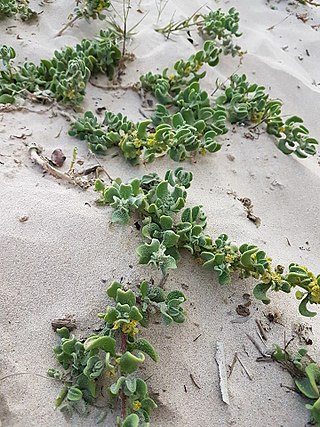
Indigofera is a large genus of over 750 species of flowering plants belonging to the pea family Fabaceae. They are widely distributed throughout the tropical and subtropical regions of the world.

Agathosma is a genus of about 140 species of flowering plants in the family Rutaceae, native to the southern part of Africa. Common names include buchu, boegoe, bucco, bookoo and diosma. Buchu formally denotes two herbal species, prized for their fragrance and medicinal use despite their toxicity. In colloquial use however, the term is applied to a wider set of fragrant shrubs or substitutes.

Heliophila is a genus of flowering plants in the family Brassicaceae. Members of this genus are either annuals or perennials and some are popular as ornamental plants. Endemic to southern Africa, the majority of the approximately 80 species grow in South Africa, particularly the Cape Floristic Region, while a few extend into the Namib Desert.

Phylica is a genus of plants in the family Rhamnaceae. It contains about 150 species, the majority of which are restricted to South Africa, where they form part of the fynbos. A few species occur in other parts of southern Africa, and on islands including Madagascar, the Mascarene Islands, Île Amsterdam, Saint Helena, Tristan da Cunha, and Gough Island. Phylica piloburmensis from the Burmese amber of Myanmar, dating to around 99 million years ago during the mid-Cretaceous, was originally described as the oldest fossil member of the genus, but subsequent studies contested its assignment to the genus Phylica and even to the family Rhamnaceae, with one study placing it in the separate genus Nothophylica.

Drosanthemum ("dewflowers") is a genus of succulent plants in the ice plant family native to the winter-rainfall regions of southern Africa, including Namibia and the Cape Provinces and Free State of South Africa. Most species bear colorful flowers.

Tetragonia decumbens is a coastal shrub, native to southern Africa.

Aizoon or Aizoön is a genus of flowering plants in the iceplant family, Aizoaceae.

Tetragonia implexicoma, commonly known as bower spinach, is a species of plant in the Aizoaceae, or ice-plant family. A similar species is Tetragonia tetragonioides, however this species has larger leaves and a shorter flowering time.

Pharnaceum is a genus of flowering plants in the family Molluginaceae, found in southern Africa. Some are annual or perennial herbs, others are shrubs or subshrubs.

Psammotropha is a genus of flowering plants belonging to the family Molluginaceae.














